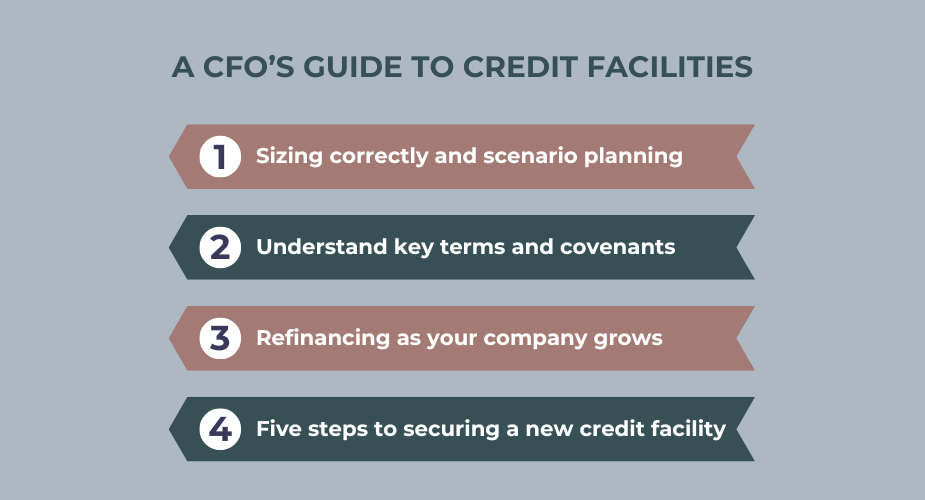How Much Corporate Debt Is Right for My Company?
Key Takeaways:
Corporate debt can be a powerful tool for growth when managed properly, offering a lower cost of capital, tax benefits, and the ability to maintain ownership control
Finding the right mix of debt and equity is crucial–the optimal level of debt varies by industry, cash flow, and market conditions
Determining the appropriate level of corporate debt depends on credit metrics, cash flow stability, liquidity requirements, and broader economic factors that requires meticulous planning
A well-structured debt plan supports growth without jeopardizing financial health
Understanding Corporate Debt
CEOs, CFOs and Executive Board members often face the question: what is the optimal level of corporate debt for our business? Striking the right balance is challenging, as it requires weighing the advantages of accessing debt against the operational and agency costs that can arise from overleveraging your company. However, investing time and effort to properly answer this question can pay off as the benefits of achieving the optimal corporate debt structure can be significant.
Debt and Capital Structure
A well-optimized debt and capital structure helps reduce the cost of capital, improves financial flexibility, and boosts shareholder value. However, achieving that balance isn’t simple. It requires careful financial analysis to ensure that your company can sustain its corporate debt without placing unnecessary strain on its operations.
There are many reasons a company may choose to raise corporate debt. Those may include: funding growth, paying a one-time dividend to shareholders, buying out existing shareholders, financing an acquisition, refinancing existing debt, or positioning the company to navigate a challenging economic environment. In every instance, it may be challenging to understand how much corporate debt is optimal for your business. Yet choosing the right amount of debt at the right cost is critical for long-term success.
The Advantages and Considerations of Corporate Debt
The benefits of corporate debt are quite compelling–there is a lower cost of capital when compared to equity, and it provides a tax advantage, as interest payments are tax-deductible. However, there can be hefty considerations, such as interest expense, risk of default, and reporting requirements.
That’s why it’s necessary to have a full picture of your financial health (which includes the health of the overall market and your specific industry/sector) before making any decisions.
Debt Financing Advantages
Debt financing typically has a lower cost of capital than raising equity, and it allows you to retain ownership, avoiding dilution of control. Interest on corporate debt may be tax-deductible, which could reduce your company’s tax burden.
Lower cost of capital vs. raising equity: Debt financing typically offers a lower cost of capital compared to issuing equity, which makes it an attractive option
Tax deductibility of interest expense: Interest payments on corporate debt might be tax-deductible, reducing your overall tax liability and freeing up cash for other strategic investments
Higher shareholder return on equity: By using debt, you can increase returns on equity without diluting ownership
Relative ease of refinancing at maturity: Corporate debt is relatively straightforward to refinance at maturity, which provides greater flexibility in managing a company’s financial obligations.
No/minimal governance rights: Unlike equity capital, most corporate debt excludes governance rights for lenders, allowing you to maintain control over the strategic decisions of your company.
Debt Financing Considerations
While the advantages of corporate debt are numerous, there are also several considerations. Debt financing entails obligations to third parties and there are generally restrictions on how the capital can be used.
Negative covenants (restrictions): Debt agreements include covenants that restrict certain business activities, limiting your ability to make operational changes without lender approval.
Necessity to maintain financial covenants: Lenders require your company to meet specific financial conditions to remain in compliance with loan agreements. This adds pressure to maintain healthy financial ratios.
Interest expense and agency costs: The cost of servicing debt, including interest and agency fees, can affect profitability and cash flow if not managed properly.
Maturity schedule: You must manage your debt repayment schedule carefully to avoid liquidity issues.
Risk of default/implications of default: Defaulting on debt obligations can severely damage your company’s financial standing and reputation and negatively impact your ability to secure future financing.
Reporting requirements: Debt financing involves periodic reporting requirements to lenders, adding administrative overhead and the need for greater transparency.
How to Determine the Optimal Amount of Debt for your Business
Academics and practitioners debate the theory behind the optimal amount of debt. Is the optimal debt structure one that minimizes cost of capital, maximizes theoretical enterprise value, aligns with a company's lifecycle or aligns with competitors?
In our experience, the optimal amount of corporate debt is highly dependent on the situation, industry, business, economic cycle, and the owner’s risk tolerance, among other factors. There are a number of tools that we use to help our clients determine the right amount of corporate debt for their business objectives. The factors will help you determine the level of debt your company can safely manage without jeopardizing its financial stability include:
Credit metrics: Evaluate your current leverage and liquidity profile, as measured by typical financial benchmarks to determine optimal credit metrics, which are industry and situation dependent. Typical credit metrics include:
EBITDA / Interest Expense
Debt / Tangible Net Worth
Cash flow: Evaluate your cash flow generation capacity and the company’s ability to repay corporate debt on time. Common cash flow characteristics to evaluate include:
Predictability of revenue
Operating efficiency / margin profile
Stability of revenue and margins
Expected capital investments (separated into maintenance vs growth capex)
Working capital requirements to support current and expected growth
Leveraged free cash flow (cash flow after capital expenditures, taxes and pro forma interest expense)
Liquidity requirements: Evaluate your ongoing liquidity needs to fund operations to determine optimal corporate debt levels. These requirements can help determine the necessary minimum size for a revolving credit facility and also peak leverage levels for covenant purposes. Liquidity measures include:
Current and expected working capital requirements
Seasonal working capital requirements
Cash conversion cycle
Growth profile: Evaluate your growth plans to understand the impact on cash flow and credit metrics as well as to assess the financial and operational risks associated with leverage.
Business / economic cycle: Evaluate your current business cycle as well as the broader economic and interest rate environment. Run sensitivity analysis to stress test your balance sheet and credit metrics.
Competitive benchmarking: Analyze the leverage profile of your competitors compared with those of the industry and your company to determine strategic opportunities and identify risks.
Credit ratings: Evaluate your current and projected credit rating, if applicable. The rating agencies like Moody’s and S&P use a variety of metrics, including many of the ones listed above, to determine the appropriate credit rating.
Corporate debt can be a powerful tool for growth, offering lower capital costs and tax advantages that can help fuel acquisitions, shareholder returns, and business expansion. By leveraging debt, you can access capital without giving up ownership, maintain control of your company, and enjoy more flexible refinancing options. However, it’s crucial to find the right balance—too much debt can lead to financial strain, while too little may result in missed growth opportunities. The optimal amount of debt maximizes growth potential while preserving financial stability and flexibility.
Keene Advisors is experienced at advising companies on a broad range of leveraged finance transactions and corporate finance matters. Our team has advised clients in connection with over $20 billion of financing commitments and corporate debt capital raising transactions. We have helped clients fund organic growth, fund dividends to shareholders, buy out existing shareholders, fund acquisitions, and refinancing existing debt. In addition, our team has advised clients on credit agreement amendments, operational and balance sheet restructurings, and a range of bankruptcy related matters.
Contact us to determine the optimal amount of corporate debt for your business.
Keene Advisors Insight Series: Corporate Debt Financing
Disclaimer: This commentary is intended for general informational purposes only. Keene Advisors does not render or offer to render personalized financial, investment, tax, legal or accounting advice through this report. The information provided herein is not directed at any investor or category of investors and is provided solely as general information. No information contained herein should be regarded as a suggestion to engage in or refrain from any investment-related course of action. Keene Advisors does not provide securities related services or recommendations to retail investors. Nothing in this report should be construed as, and may not be used in connection with, an offer to sell, or a solicitation of an offer to buy or hold, an interest in any security or investment product.









